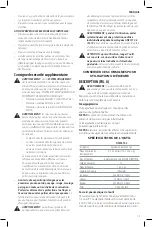
English
5
system. The supply hose should contain a fitting that will
provide “quick disconnecting” from the male fitting on
the tool.
supply source
Use only clean regulated compressed air as a power source
for this tool. NEVER USE OXYGEN, COMBUSTIBLE GASES, OR
BOTTLED GASES, AS A POWER SOURCE FOR THIS TOOL AS
TOOL MAY EXPLODE.
Regulator
A pressure regulator with an operating pressure of
0–120 p.s.i.g. (0–8.5 kg/cm²) is required to control the
operat iing pressure for safe operation of this tool. Do not
connect this tool to air pressure which can potentially
exceed 200 p.s.i.g. (14 kg/cm²) as tool may fracture or burst,
possibly causing injury.
Operating Pressure
Do not exceed recommended maximum operating pressure
as tool wear will be greatly increased. The air supply must
be capable of maintaining the operating pressure at the
tool. Pressure drops in the air supply can reduce the tool’s
driving power. Refer to
Tool Specifications
for setting the
correct operating pressure for the tool.
Filter
Dirt and water in the air supply are major causes of
wear in pneumatic tools. A filter will help to get the best
performance and minimum wear from the tool. The
filter must have adequate flow capacity for the specific
installation. The filter has to be kept clean to be effective
in providing clean compressed air to the tool. Consult the
manufacturer’s instructions on proper maintenance of your
filter. A dirty and clogged filter will cause a pressure drop
which will reduce the tool’s performance.
OPERATION
WARNING: To reduce the risk of serious personal
injury, turn unit off and remove air supply before
making any adjustments or removing/installing
attachments or accessories.
An accidental
actuation can cause injury.
Preparing the Tool
WARNING:
Read the section titled
IMPORTANT
SAFETY INSTRUCTIONS
at the beginning of this
manual. Always wear proper eye [ANSI Z87.1 (CAN/
CSA Z94.3)] and hearing protection [ANSI S12.6
(S3.19)] when operating this tool. Keep the tool
pointed away from yourself and others. For safe
operation, complete the following procedures and
checks before each use of the fastener.
• Before you use the tool, be sure that the compressor
tanks have been properly drained.
• Wear proper eye, hearing and respiratory protection.
• Remove all fasteners from the magazine.
• Check for smooth and proper operation of contact
trip and pusher assemblies. Do not use tool if either
assembly is not functioning properly. NEVER use a tool
that has the contact trip restrained in the up position.
• Check air supply: Ensure air pressure does not exceed
operating limits; 120 p.s.i.g., (8.5 kg/cm
2
).
• Connect air hose.
• Check for audible leaks around valves and gaskets.
Never use a tool that leaks or has damaged parts.
Proper Hand Position (Fig. B)
WARNING:
To reduce the risk of serious personal injury,
ALWAYS
use proper hand position as shown.
WARNING:
To reduce the risk of serious personal
injury,
ALWAYS
hold securely in anticipation of a
sudden reaction.
Proper hand position requires one hand on the handle
8
.
8
Fig. B
Loading Fasteners (Fig. C)
WARNING:
Keep the tool pointed away from yourself
and others. Serious personal injury may result.
WARNING:
Never load fasteners with the contact trip
or trigger activated. Personal injury may result.
WARNING:
Always disconnect the tool from the air
supply before making any adjustments or attemping
any repairs to the tool.
1. Move pusher
4
to rear until latched. Cover will open.
Pusher will be held in place by the pusher release
2
.
2. Drop fasteners over magazine
5
and slide forward.
Repeat until magazine is loaded.
3. Pull pusher back slightly and depress pin detents. Allow
pusher to slide forward over the pin detent.
Fig. C
5
4
2








































